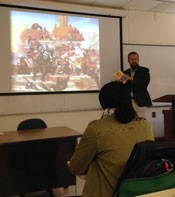First Worlds of Mexico lecture recounts the fall-out from first contact in the Americas

Donald S. Anderson, adjunct professor of anthropology, discussed the calamitous effects of the first contact between Europeans and indigenous peoples of Central America and Mexico during the first of the four-part World of Mexico Lecture Series.
When a "rag tag bunch of guys" met the mighty Aztec empire, the empire fell.
The first contact between Europeans and the Aztec empire at the turn of the 16th century was an event of global importance, said David S. Anderson, adjunct professor of anthropological sciences.
"It was an earth-shattering moment from big to little," Anderson told more than 30 students and faculty in the first of the four-part Worlds of Ancient Mexico Lecture Series Oct. 21 in Whitt Hall. "It caused drastic changes to the world – the death of millions, the disappearance of cultures and two new continents sprung up. We saw wealth forcibly extracted from the Americas drive the Renaissance and the tomato was introduced to Europe. Can you imagine Italian cuisine without tomato paste?"
The agent of this cataclysmic event was Hernando Cortes, the first of the famous Spanish conquistadors. Cortes' encounter with the natives of Central America and Mexico introduced the Aztec, Incan and Mayan empires to strains of smallpox and measles that crippled them and sped their downfall.
"It is widely reported that Cortes, with his guns and horses, were able to overthrow this empire," said Anderson. "In reality, what we're looking at here is - Cortes lights a match."
Fueling the fall of the empires, that included cities larger than any known European cities at the time, was the inadvertent exposure to disease and the smoldering discontent of the empire's indigenous subjects.
After first contact, Anderson said that the waves of conquistadors that followed Cortes entered a continent whose residents had been ravaged by disease and had lost their cultural core.
"We see the push toward general destruction that follows," Anderson said, in his presentation that also touched on some of the political intrigue and romantic machinations that Cortes used to make the transformational expedition.
Anderson talked of Marina, Cortes' paramour and the daughter of the chief of a native tribe, who was instrumental in Cortes' engaging the various tribes he recruited to an army that swelled to 20,000. Anderson also recounted some of Cortes' machinations to give his adventure legal and royal sanction.
An archaeologist who has worked in Mexico since 1999, Anderson recently spent a month in Central Mexico studying the Aztec codices, indigenous books pre-dating the Spanish conquest of Central America, as part of a National Endowment of Humanities grant.
The upcoming Worlds of Ancient Mexico lecture schedule is:
- Force and Finesse: Power in the Ancient City of Teotihuacan - Wed., Nov. 5
- Past and Present: Visions of Aztlan - Wed., Nov. 12
All lectures will be in Whitt 204. They are free and open to the public. For more information, contact Anderson at danderson10@radford.edu.